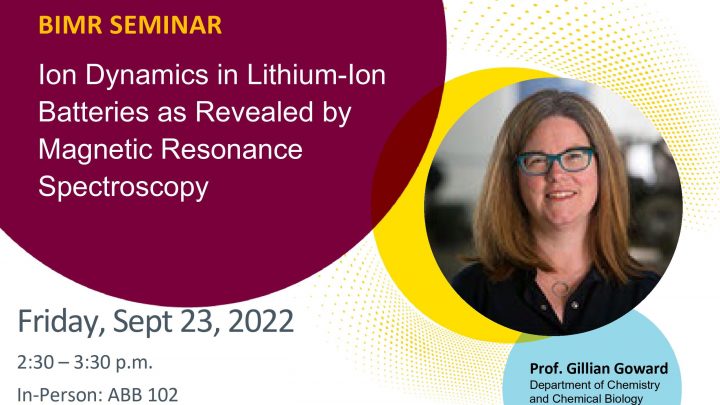Ion Dynamics in Lithium-Ion Batteries as Revealed by Magnetic Resonance Spectroscopy
Sep 23, 2022
2:30PM to 3:30PM

Date/Time
Date(s) - 23/09/2022
2:30 pm - 3:30 pm
Categories
Prof. Gillian Goward
Department of Chemistry and Chemical Biology
McMaster University
Ion dynamics within solid-state structures govern the performance of devices like lithium and sodium ion batteries. Magnetic resonance spectroscopy provides valuable tools for examining the properties of lithium or sodium ions within electrode and electrolyte materials. This talk will give an overview of magnetic resonance techniques implemented to characterize ion dynamics and changes in electrode structures that occur during electrochemical cycling, focusing on two specific examples. We utilize ex situ nuclear magnetic resonance (NMR) spectroscopy applied under fast Magic Angle Spinning (MAS) to acquire high-resolution spectra of paramagnetic electrode materials such as LiFeV2O7, a mix-transition metal cathode material with promising capacity.[1] Here solid-state NMR exchange data reveal a significant change in the local ion dynamics during the lithiation process. This is paired with density functional theory calculations which aid in the assignment of the 7Li NMR spectra, and synchrotron operando PXRD data acquired at the Canadian Light Source, which reveal the changes in the framework lattice, which accompany the changing ion mobility.
The development of optimal fast charging protocols requires detailed information about the lithium inventory in the battery. Moving from ex situ characterization to operando methods, NMR spectra can be acquired while an electrochemical cell is repeatedly charging/discharging, permitting the quantification of various phases existing within the battery in real time. We have recently reported the development of a parallel-plate resonator (PPR) RF probe and a cartridge-type single layer cell of improved designs. The probe has excellent B1-field homogeneity, and exhibits approximately three-times higher sensitivity than a comparable operando NMR probe that uses a solenoidal coil. Using this probe assembly, operando 7Li NMR measurements were acquired. At low (C/10) charging rates the usual sequencing of lithiated graphite, LixC6, phases from dilute to concentrated is exhibited, while at high (1C) rates a direct transition to, and propagation of concentrated phases throughout the graphite electrode is observed, with no evidence for the formation of dilute phases. Concurrently, a peak assigned to plated Li metal forms. Thus, we can conclude that Li accumulates on the surface of graphite at high charging rates. Moreover, some of the deposited Li metal is observed to intercalate into graphite, though a significant fraction accumulates during consecutive cycles. Such real-time observations of electrochemical cells will contribute to optimizing performance in electrochemical devices.
- Pereira, T.L.E., Sanders, K. J., Smiley, D.L., Britten, J.B, Goward, G.R. Chemistry of Materials. (2022). “Structural Complexity and Evolving Lithium-ion Dynamics Within the Cathode Material LiFeV2O7 Revealed by Diffraction and Solid-state NMR”. In press.
- Sanders, K.J., Keffer, J.R., Aguilera, A. R., Balcom, B. J., Halalay, I.C., Goward, G. R., (2022) “Transient lithium metal plating on graphite: Operando 7Li nuclear magnetic resonance investigation of a battery cell using a novel RF probe”. Carbon 189 (377-385) org/10.1016/j.carbon.2021.12.082
Biography:
Professor Gillian Goward is a faculty member in the Department of Chemistry and Chemical Biology at McMaster University. She a recipient of a 2020 Faculty of Science Research Chair in Magnetic Resonance Studies of Energy Materials. Her particular focus is on characterizing the structure and dynamics of frameworks and charge carriers in Li-ion batteries and other energy storage and conversion materials, through advanced multi-nuclear NMR methods including in situ spectroscopic and spatially resolved imaging studies. She participates actively in the Canadian and international NMR and Materials Chemistry communities, and she is also a senior editor for the American Chemical Society publication, the Journal of Physical Chemistry.

